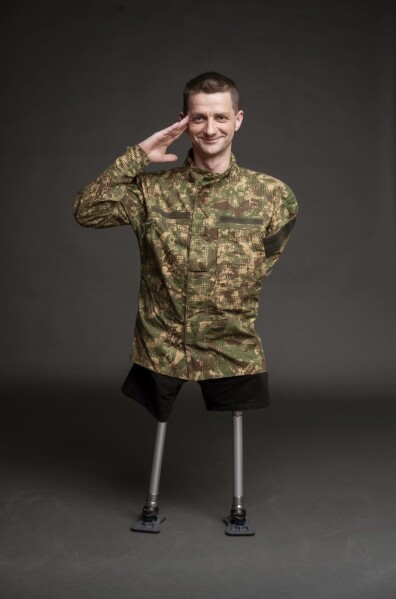Posts misrepresent a photo of a Ukrainian soldier balancing on his prosthetic limbs
CLAIM: A photo shows a Ukrainian soldier from the Azov Regiment who lost both legs and his left arm in the Russia-Ukraine war giving the Nazi salute.
AP’S ASSESSMENT: False. The soldier, Roman Tsymbalyuk, was attempting to steady himself while waving and giving a traditional military salute on his new prosthetic legs, according to those present when the photo was taken. Tsymbalyuk posted the image on social media without realizing it could appear he was giving the Nazi salute, but removed it when he noticed the resemblance. He and others familiar with his military background say he has no connection to the Azov Regiment.
THE FACTS: Social media users are sharing the photo of Tsymbalyuk with erroneous information, furthering false claims about Nazism’s influence in Ukraine that have spread widely since Russia invaded the country more than two years ago.
The image shows a smiling man in a military jacket raising his right arm in front of him. He is missing his left arm and is wearing prostheses in place of both of his legs.
“Azov Battalion member lost both legs and an arm but can still do this,” reads one X post that also included an image of the same man in civilian clothing, sitting on a chair without his prostheses, his right arm in a resting position. It had received approximately 18,000 likes and 4,300 shares as of Thursday.
But Tsymbalyuk, who is from the western Ukrainian city of Khmelnytsky and previously worked as a car repairman, was not signaling support for Nazi ideals. He was just trying to make sure he didn’t fall over, according to those present when the photo was taken.
Both photos were taken as part of publicity shoots organized by the Protez Foundation, a nonprofit that provides free prostheses to Ukrainians who have lost limbs in the Russia-Ukraine war. Tsymbalyuk was part of the latest group it had brought to the U.S. to receive medical care.
The Associated Press is sharing other photos from one of the shoots, but not the image with the raised arm to avoid the possibility of further misrepresentation.
Andrey Madan, executive program director of the Protez Foundation, told the AP that the image of Tsymbalyuk raising his hand captured a moment in which he was trying to maintain his balance, as he is still getting used to his prostheses and was standing on a new type of surface, while waving and giving a traditional military salute.
Madan said that Tsymbalyuk posted the photo on his Instagram and TikTok accounts before he realized how it would be viewed and removed it two to three days later when he made the connection. He added that Tsymbalyuk is “of course” not a Nazi or a fascist and called the claims “ridiculous.”
“Protez Foundation does not endorse or support any political, extremist or terrorist organizations including but not limited to nationalists (nazi), supremacists, terrorists, etc.,” Madan wrote in an email.
Based in Oakdale, Minnesota, the Protez Foundation works with Ukrainian soldiers and civilians, including children, who have been affected by the Russia-Ukraine war. In addition to providing people with prostheses, the nonprofit also offers them mental health and emotional support, according to its website.
Patients are brought to the U.S. to receive their prostheses and are provided with follow-up care once they return to Ukraine. As of December 2023, the organization had given 360 prostheses to 135 patients. “Protez” is Ukrainian for “prosthesis.”
The “Azov Battalion” refers to a group that formed in 2014 as one of many volunteer brigades created to fight Russia-backed separatists in eastern Ukraine and drew its initial fighters from far-right circles. This group grew into what is now known as the Azov Regiment, a unit within Ukraine’s National Guard.
Russia has repeatedly portrayed the Azov Regiment as a Nazi group and accused it of atrocities, but has publicly produced little evidence. Current Azov Regiment members reject accusations of extremism.
In a video sent to the AP, Tsymbalyuk explained in Ukrainian that he was only trying not to fall down and that he does not support fascism. He also confirmed that he was not part of the Azov Regiment.
Lesia Borodina, the photographer who shot the picture of Tsymbalyuk, further verified that “there is no subtext” to the image spreading online.
“Roman was positioned and left alone, but he started losing balance, and to stay on his feet, he began to sway,” she wrote in an email. “Since he only has his right hand, he used it to balance and prevent falling. He managed to stay on his feet (prosthetics) by stretching his arm sideways, and at that moment, I took the photo. Roman always tries to keep a smile, so the photo is positive here too.”
Borodina added that she gave Tsymbalyuk the photo of him losing balance as a “keepsake.”
Russian President Vladimir Putin told the world in the lead-up to Russia’s 2022 invasion of Ukraine that his goal was to “denazify” the country, despite the fact that it has a Jewish president who lost relatives in the Holocaust and has a Western-backed, democratically elected government.
Russia has often tried to link Ukraine to Nazism, particularly those who have led it since a pro-Russian leadership was toppled in 2014. Since this time, some Ukrainian politicians have sought to glorify certain nationalist fighters from the World War II era, focusing on their opposition to Soviet rule rather than their welcoming of the Nazis.
The AP has reported, however, that claiming Ukraine’s current government is a Nazi state is a leap that does not reflect the reality of the country’s politics.
___
This is part of the AP’s effort to address widely shared false and misleading information that is circulating online. Learn more about fact-checking at AP.




